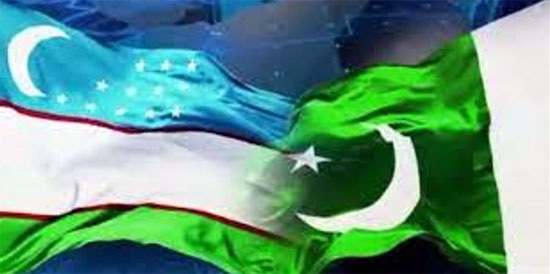Dr. Mehmood Ul Hassan
China Pakistan Economic Corridor (CPEC) has brightened the prospects of greater regional connectivity with Central Asia States with its proposed mega projects of railways ML-I and completion of numerous infrastructural projects in the country.
On the other hand Pakistan and the Republic of Uzbekistan’s bilateral relations are getting momentum because of constant high level political consultation, economic liaison and social connectivity between the two countries.
Critical analysis of bilateral trade of both countries transpired that in the past, bilateral trade stood at only $20 million, which reached $185 million in 2021. In this connection, hopefully PTA will increase the trade further. Now agreements are being signed between the provinces and cities of Pakistan and Uzbekistan for mutual cooperation which would be value addition for the further strengthening of bilateral relations between two countries.
Both countries have already signed Preferential Trade Treaty (PTA) and now rigorous ministerial work is going on to possibly ink the Free Trade Agreement (FTA) which will be a value addition to further accelerate bilateral trade between the two countries.
Moreover, a Transit Trade Deal (TTD) has been signed by the two countries, which facilitated the movement of goods via land route between the two countries including through trucks. It has already streamlined and systemized custom forwarding & clearance formalities. For further strengthening of bilateral trade cooperation, a similar trilateral agreement between Afghanistan, Pakistan and Uzbekistan are being seriously considered. It would further enhance chances of greater regional connectivity and socio-economic integration between Central Asia and South Asia and regional trade would be also benefited.
Pakistan and Uzbekistan have been striving hard to promote regional connectivity through innovative means of integrated transport system and mega railway project of Pakistan-Afghanistan and Uzbekistan. Now the engineers and technical staff of both countries are carrying out work on the project and all the three parties, including Afghanistan, agreed to implement it. Interestingly, Afghanistan’s province of Mazar-e-Sharif is already connected to Uzbekistan through a railway line.
Moreover, the railway link between Pakistan, Afghanistan and Uzbekistan will not only link trade with the countries in the two regions, but will also give access to the Euro-Asian and European markets.
Comparative study of Uzbekistan reveals that it has the highest population among the Central Asian Republics (CAR), but the country’s population is still roughly a sixth of the population of Pakistan. Pakistan also has a GDP almost five times that of Uzbekistan. However, the GDP per capita of Uzbekistan is much higher than that of Pakistan.
However, Uzbekistan is the shortest and sustainable gateway of greater regional connectivity because it has already built railway connection with middle corridor Afghanistan which is commendable.
According to Asian Development Bank (2022), Uzbekistan’s economy is expected to grow by 5 percent this year and by 5.5 percent next year assuming a smooth coronavirus disease (COVID-19) vaccine rollout and the rapid recovery for industry, services, investment, and private consumption continues. Exports of goods and services notably of copper, gold, agricultural products, and petrochemicals are projected to grow by 9 percent in both 2022 and 2023.
The International Monetary Fund (IMF) improved its estimate of Uzbekistan’s economic growth in 2021-2022 to 6.1 percent. Prior to this, the World Bank also improved its economic growth forecast for Uzbekistan from 4.8 to 6.2 percent. So macro-economy of Uzbekistan is achieving new heights.
The government of Uzbekistan has already initiated broad economic reforms to cover energy in 2019 when the government launched a multiphase transition from the state-owned and -operated and subsidised energy sector model to competitive gas, oil and electricity markets with significant private-sector participation and cost-covering energy prices.
Uzbekistan transformation into a green economy would be achieved thorough raising climate awareness, strengthening institutional coordination to plan green public investment, and creating an enabling environment to develop green financing. In this regard, expanding public-private partnerships and credit guarantees would help mobilize private investment in renewable power generation and other essential infrastructure.
Uzbekistan has adopted its five-year “Development Strategy for 2022-2026”. It consists of seven priority areas which will achieve one hundred goals during said period. It will assist the government to join a number of “states with the above-average income”.
Further economic liberalisation, privatisation in most spheres, competition, elimination of monopolisation, the attraction of more foreign investment, price stabilisation, support of the development of “driver spheres of the economy,” and further decentralization to the regions are among many other priorities identified in the Development Strategy for 2022-2026.
It upholds to achieve a 1.6 time increase in the GDP in next five year and the per capita income to reach $4,000 by 2030 by ensuring stable high growth rates in all sectors of the economy, including energy, industry, machinery, mining, agriculture and others. It will ensure macroeconomic stability and gradually reduce the annual inflation rate to 5 per cent by 2023.
The proposed industrial policy reforms ensure the stability of the national economy and increase the share of industry in GDP by increasing the volume of industrial production by 40 per cent. Implementation of large investment projects in metallurgy, such as an increase in the production volumes of gold by 26 per cent and silver by 42 per cent, and a 2-fold increase in copper and ferrous metal products will be achieved.
Production in the chemical industry will be worth $2 billion by developing the chemical and gas chemical industries and bringing the level of natural gas processing from 8 to 20 per cent. Additionally, the plan calls for double the production of building materials, growth in the leather and footwear industry by 3.2 times its current size, a three times increase in pharmaceutical industry products, and furniture products growing by 2.8 times.
By 2026, there is a planned increase in electricity production by an additional 40 billion kW/h, bringing the total to110 billion kW/h. Furthermore, the government intends to save about 3 billion cubic meters of natural gas by bringing the share of renewable energy sources up to 25 per cent of energy production by 2026. In conjunction with this, reducing the emission of harmful gases into the atmosphere in the amount of 8 million tons is also a priority.
Another important goal is the transformation of the digital economy into the core “driver” sphere of the economy. Implementing work aimed at increasing the digital economy’s volume by at least 2.5 times is also a goal to strengthen the country’s potential in this new sphere.
The Uzbek government is taking all possible measures to attract the necessary $120 billion over the next five years, including foreign investment of $70 billion, is another crucial goal for the government to realise. Moreover, the country is planning to reform its capital markets. Thus, it is planning to increase financial resources in the economy by bringing the capital market volume from $200 million to $7 billion over the next five years.
Completion of the transformation of the banking system, bringing the share of banking assets of private banks from 20 to 60 per cent in 2025, in general, is a goal to reform the banking sector and increase the affordability of decent banking services.
Uzbekistan plans to increase the country’s exports by 2026 to $30 billion to maintain sustainable economic development. Hence, bringing the share of the private sector in exports to 60 per cent is a priority. Accordingly, by improving the system of providing organisational and financial assistance to exporting enterprises, the country is willing to increase the current number of exporting enterprises from 6,500 to 15,000. Expanding the geography of exports of goods from 115 to 150 countries is also expected.
To further support entrepreneurship, the government plans to reduce the tax burden on business entities by 2026 from 27.5 per cent to 25 per cent of GDP and decrease VAT from 15 to 12 per cent, as well as reducing profit tax for telecommunications, banking and finance sectors from 20 per cent to 15 per cent.
The government is planning to increase the economic potential of the regions by carrying out decentralisation reforms to support the development of the districts further. Keeping in mind that agriculture reserves a high volume in the state’s GDP, the annual growth rate of agriculture is expected to be at least 5 per cent, which should lead to the increase of farmers’ incomes by at least two times. Furthermore, Uzbekistan plans to implement a more differentiated approach in developing districts and communities
Pakistan-Uzbekistan Economic Road Map
(1) Early signing of FTA is must for further strengthening of bilateral relations in diverse sectors of economy, investments, trade & commerce, joint ventures, banking & finance, civil aviation, culture, tourism and education cooperation between two countries.
(2) Implementation of PTA on non-traditional trade items may further increase volumes of trade between two countries. Marbles, ceramic tiles, dry fruits, saffron and dairy products should also be included in the PTA.
(3) Further diversification of scope, utility and outreach of Pak-Uzbek bilateral relations is the need of hour. Uzbekistan has great prospects and potential for the growth of tourism. There are over 7,000 sites of historical, architectural and archeological importance in Uzbekistan. Of these, 545 are architectural, 575 historical, 1,457 are related to art, and 5,500 are related to archeology. 209 of them are included in the UNESCO World Heritage List. Thus mutual cooperation in tourism should be further increased through meaningful measures.
(4) Easy and smooth issuance of visa should be mantra of both the countries. Inclusion of Pakistan into free entry status would be value addition to enhance tourism between two sides. Tourism agency arrangements would be an innovative idea to increase joint cooperation in tourism.
(5) Further systemized operationalization and channelization of mutual banking & finance cooperation may achieve wonders between two countries. It will provide essential financial stimulation for the development of SMEs, Micro-Financing, Islamic Banking and last but not least Insurance Companies.
(6) Formation of joint production units in textiles, garments and fashion industry may be an innovative idea which may further increase economic potential of both the countries.
(7) Automobile industry is another potential area of strategic cooperation because now Pakistan’s domestic automobile industry has also developed enough to assemble and locally produced all kinds of cars and SUVs which may be clubbed with Uzbek partners.
(8) Formation of Reciprocal Trade Houses (RTHs) in Karachi and Tashkent would be mutually beneficial.
(9) Streamlining of trade through TIR, Cluster & integrated transport system, commercial cargos and Gwadar & Karachi ports would further enhance trade between two countries.
(10) Joint production of cement may be another area of potential cooperation because of immense infrastructural development in both the countries.
(11) Chemical industry including fertilizers and petro-chemical industrial cooperation would be a value addition.
(12) Batter trade of vegetables and spices would be a win-win proposition for both the countries.
(13) Trade in respective national currencies would further open-up prospects of greater connectivity.
(14) Regular holding of One Country Product Exhibition should be promoted on regular basis.
(15) Formation of a genuine Pak-Uzbek Chamber of Commerce is the need of hour. Private companies of both sides should assist to reactivate Sick Units between two countries.
(16) Formation of joint Special Free Economic Zones would further support trade & commerce, business, investment and joint ventures activities between two sides.
(17) Mutual cooperation in sports, surgical goods, vaccines, science & technology and education may bring desired goals of greater trade volumes.
(18) Benefiting propositions of mutual military cooperation may be paradigm shift between two sides.
(19) Energy cooperation especially in green technologies and development of renewables would be win-win situation for both the countries. Uzbekistan is considering building its first nuclear energy in the country. Thus nuclear energy cooperation may another area of cooperation between two sides.
(20) Agro-Industrial cooperation would further enhance cooperation in agricultural production, and agro-machinery.
To conclude China Pakistan Economic Corridor (CPEC) would play vital role in the further strengthening of bilateral relations in diverse sectors of economy, trade, investments, connectivity and cooperation between two countries in the days to come.
(The author is Director:
The Center for South Asia & International Studies (CSAIS) Islamabad Regional Expert: Uzbekistan & CIS )






